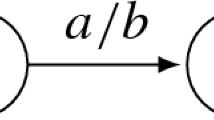Abstract
Abstract. The paper considers a new algebraic object, the completely automaton binomial algebras, which generalize certain existing classes of algebras. The author presents a classification of semigroup algebras taking into account completely automaton algebras and gives the corresponding examples. A number of standard algorithmic problems are solved for completely automaton binomial algebras: the recognition of a strict and nonstrict polynomial property, the recognition of the right and/or left finite processing, and the construction of the determining regular language for an algebra with finite processing and for monomial subalgebras of a free associative algebra and certain completely automaton algebras. For an automaton monomial algebra, the author constructs the left syzygy module of a finite system of elements and the Gröbner basis of a finitely generated left ideal; also, some algorithmic problems are solved.
Similar content being viewed by others
References
V. N. Latyshev, Combinatorial Ring Theory. Standard Bases [in Russian], MGU, Moscow (1988).
T. Becker and V. Weispfenning, Gröbner Bases, Springer-Verlag (1993).
A. Ya. Belov, V. V. Borisenko, and V. N. Latyshev, “Monomial algebras,” in Progress in Science and Technology, Series on Contemporary Mathematics and Its Applications, Thematical Surveys [in Russian], Vol. 126, All-Russian Institute for Scientific and Technical Information, Russian Academy of Sciences, Moscow (2002), pp. 35–214.
D. I. Piontkovskii, “Noncommutative Gröbner bases, coherence, and divisibility in semigroups,” Fund. Prikl. Mat., 7, No. 2, 495–513 (2001).
A. Salomaa, Pearls of Formal Language Theory [Russian translation], Mir, Moscow (1986).
J. Måanson, and P. Nordbeck, “Regular Gröbner bases,” Symbolic Comput., No. 33, 163–181 (2002).
A. Ya. Belov, Linear Recurrent Equations [in Russian], International University of Bremen, Moscow Institute of Open Education (2003).
D. Eisenbud, I. Peeva, and B. Sturmfels, “Non-commutative Gröbner bases for commutative algebras,” Proc. Amer. Math. Soc., 126, No. 3, 687–690 (1998).
D. Eisenbud, Commutative Algebra with a View toward Algebraic Geometry, Springer-Verlag, New York (1995).
U. U. Umirbaev, “Some algorithmic problems of associative algebras,” Algebra Logika, 32, No. 4, 450–470 (1993).
L. Yu. Kasapenko, On Recognizable Properties of Associative Algebras [in Russian], Dissertation, Ul’yanovsk (2000).
Author information
Authors and Affiliations
Additional information
__________
Translated from Sovremennaya Matematika. Fundamental’nye Napravleniya (Contemporary Mathematics. Fundamental Directions), Vol. 20, Algebra, 2006.
Rights and permissions
About this article
Cite this article
Ilyasov, S.A. Recognition of certain properties of automaton algebras. J Math Sci 152, 95–136 (2008). https://doi.org/10.1007/s10958-008-9048-9
Published:
Issue Date:
DOI: https://doi.org/10.1007/s10958-008-9048-9




